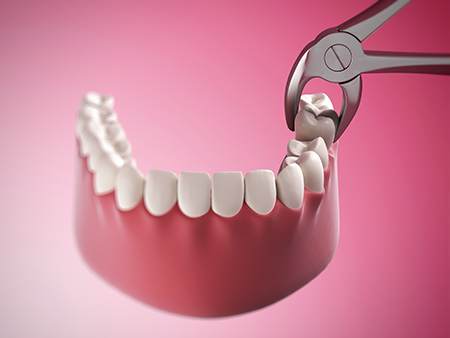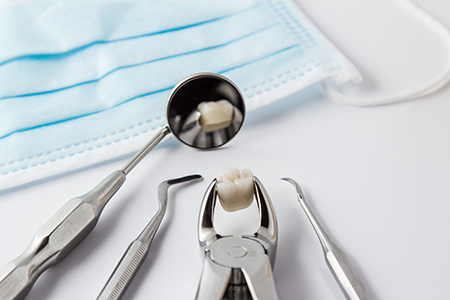Existing Patients
(740) 393-2161
New Patients
(740) 200-4777

Your comfort, safety, and long-term oral health guide every decision we make at the office of Brian Howe DDS, Family Dentistry. While saving a natural tooth is always preferred, extraction becomes the most responsible option when a tooth threatens surrounding structures, function, or overall well-being. We focus on clear communication so you understand why extraction is recommended and how it fits into your broader treatment plan.
Tooth removal is not an isolated event — it’s part of a continuum of care. Before recommending extraction, our team evaluates your medical history, conducts a clinical exam, and reviews diagnostic images to confirm that removal is the best course. When an extraction is recommended, we explain the reasons, outline alternatives when appropriate, and answer your questions so you can make an informed decision.
We take extra care to reduce anxiety and minimize discomfort. Depending on the situation and your personal preferences, local anesthesia, nitrous oxide, or oral sedation can be used to keep you comfortable throughout the procedure. Our goal is not only a successful extraction but also a smooth, well-managed recovery.
Over-retained primary (baby) teeth that disrupt development
Sometimes a primary tooth remains in place after its permanent successor is ready to erupt. This can happen when the baby tooth’s roots fail to resorb or when the tooth becomes fused to the jawbone. Removing the persistent primary tooth can allow the permanent tooth to emerge correctly and support proper bite development.
Permanently damaged teeth that cannot be restored
Extensive decay, trauma, or structural loss can leave a tooth too compromised for predictable restoration. When the remaining structure cannot support a crown or filling and the risk to surrounding tissues is high, extraction is the safest remedy to prevent infection and preserve oral health.
Severe fractures or cracks that undermine tooth integrity
Teeth can sustain complex fractures that extend below the gumline or into the root, making repair unlikely to succeed. In such cases, removal prevents ongoing pain and potential infection and allows planning for replacement options that restore function and appearance.
Advanced periodontal disease compromising support
When gum disease progresses unchecked, it can destroy the bone and soft tissues that anchor teeth. Severely loosened teeth or those with deep pockets and active infection may need to be removed to control disease and protect adjacent teeth and overall oral health.
Impacted, misaligned, or decayed third molars (wisdom teeth)
Wisdom teeth often lack the space to erupt normally and can cause crowding, decay, or damage to neighboring teeth. Extraction is commonly recommended for impacted or problematic third molars to prevent future complications and maintain the health of the mouth.
Extractions as part of orthodontic treatment
In some orthodontic cases, selective tooth removal creates the space needed to align the bite and teeth effectively. When recommended, extractions are planned carefully with orthodontic goals in mind so that the final result is functional, stable, and esthetic.

Before any procedure, we perform a full review of your medical and dental history to identify potential risks and tailor care. We’ll discuss medications, allergies, and existing health conditions so the treatment plan supports your overall health. If medical clearance or preoperative antibiotics are appropriate, we coordinate those arrangements before proceeding.
Diagnostics such as digital radiographs are used to evaluate root shape, nearby anatomical structures, and bone levels. These images help determine whether the removal is expected to be straightforward or if a surgical approach will be required. Based on this assessment, we explain the steps of the procedure and the anesthesia options available.
On the day of extraction, you’ll receive anesthesia appropriate to the procedure — local anesthetic alone for most simple extractions, with sedation options available for patients who prefer additional relaxation. Our team monitors comfort and safety throughout the appointment, and we make sure you understand immediate aftercare before you leave the office.
A simple extraction is used when the tooth is fully visible in the mouth and root anatomy is favorable. After numbing the area, the dentist gently loosens the tooth and removes it using forceps. The procedure is typically quick, and post-operative discomfort can be managed with common measures and short-term medications when necessary.
If you have dental anxiety, we offer comfort-focused measures and sedation options to help you remain relaxed. Our emphasis is on providing a calm, controlled environment and on explaining each step so you know exactly what to expect.
Surgical extraction is indicated for teeth that are broken below the gumline, impacted, or ankylosed (fused to the bone). This procedure involves a small incision in the gum and, if needed, removal of a modest amount of bone to access the tooth. Surgical extractions are performed with appropriate anesthesia and are sometimes referred to an oral surgeon when complexity or medical factors warrant specialized care.
After a surgical extraction, additional instructions and close follow-up help ensure predictable healing. We discuss pain control, wound care, and the timeline for next steps — including whether, when, and how a replacement tooth should be planned.

Recovery after an extraction is generally predictable when post-operative instructions are followed. You’ll receive guidance on controlling bleeding, managing swelling, and protecting the forming blood clot that is essential to healing. Small, careful actions in the first 24–72 hours make a big difference in comfort and outcome.
We tailor aftercare recommendations to the complexity of the extraction. Simple removals often heal quickly with basic precautions, while surgical cases may need a longer period of monitoring and more detailed wound care. If you have ongoing medical conditions or medications that affect healing, we coordinate recommendations with your medical providers as needed.
Follow-up is an important component of recovery. Whether it’s a brief check-in call or an in-office appointment to remove sutures or review healing, we ensure that your recovery is progressing as expected and that any concerns are addressed promptly.
Maintain gauze pressure
Bite gently on the gauze placed over the socket to help the initial clot form. Change gauze as directed and maintain firm, steady pressure until bleeding slows. Some light oozing for up to 24 hours can be normal; call us if bleeding seems excessive or persistent.
Protect numb tissues
Avoid chewing, touching, or placing hot objects near the area until local anesthetic wears off. Numb lips, tongue, or cheeks are vulnerable to accidental bites or burns.
Take prescribed medications as directed
If antibiotics or pain medications are prescribed, take them exactly as instructed. Over-the-counter analgesics may be recommended for mild discomfort unless otherwise advised.
Antibiotics:
Complete the full course if prescribed to reduce the risk of infection after surgery.
Pain management:
Starting analgesics before anesthesia fully wears off can reduce peak discomfort. Use only the medication types recommended by your provider.
Avoid actions that disturb the clot
Do not rinse vigorously, spit forcefully, use a straw, or smoke for several days. These actions can dislodge the clot and lead to delayed healing or a painful condition called dry socket.
Manage swelling with cold
Apply ice packs to the face in short intervals during the first 24 hours to minimize swelling. Keep your head elevated when resting to further reduce swelling and bruising.
Eat soft, soothing foods
Stick to cool or lukewarm soft foods and liquids for the first day or two. Gradually reintroduce firmer foods as comfort allows, avoiding hard, crunchy, or spicy items that could irritate the site.
Gentle oral hygiene
Keep the rest of your mouth clean by brushing and flossing carefully away from the extraction site. After 24 hours, a gentle saltwater rinse can help maintain cleanliness without disturbing the healing socket.
Attend follow-up care
Return for any recommended follow-up appointments so we can monitor healing, remove sutures if necessary, and discuss timing for tooth replacement when appropriate.
If you notice increased bleeding, severe or worsening pain, persistent swelling, or other unusual symptoms, contact our office so we can evaluate your recovery and provide prompt care.

At Brian Howe DDS, Family Dentistry we combine experienced clinical judgment with modern tools to perform extractions safely and respectfully. Our focus is on preserving surrounding tissues, minimizing trauma, and setting the stage for the best long-term outcome — whether that means retaining nearby teeth, supporting healing for future restorations, or planning a replacement tooth.
When a tooth is removed, we discuss the appropriate replacement options so you can make a decision that suits your health, function, and cosmetic goals. Common solutions include dentures, fixed dental bridges, and dental implants. Each option has distinct benefits and timelines; we’ll outline realistic expectations and the sequence of care involved.
Coordination of care is central to our approach. If additional specialty care is recommended, such as advanced surgical removal or complex implant placement, we work closely with trusted colleagues to ensure seamless treatment. Throughout the process, our team emphasizes clear communication, attentive follow-up, and practical guidance to support your recovery and restoration.
In summary, tooth extraction is a considered clinical choice aimed at protecting your oral health and comfort. If you have questions about whether extraction is the best option for you, or want to learn more about the procedure and recovery, please contact us for more information.
Extraction is recommended when a tooth poses a risk to surrounding teeth, has irreversible damage, or cannot be predictably restored with conservative treatment. Common reasons include severe decay, advanced periodontal disease, complex fractures, impacted third molars, or teeth that interfere with orthodontic treatment. Before any recommendation, a clinical exam, review of medical history, and diagnostic imaging are used to confirm that removal is the best option.
At Brian Howe DDS, Family Dentistry we discuss alternatives whenever feasible and explain why extraction may offer the safest path to protect oral health. The decision to remove a tooth is made in the context of a broader treatment plan that considers replacement options and long‑term function. Clear communication about risks, benefits, and next steps helps patients make informed choices.
A simple extraction is used when the tooth is fully visible in the mouth and the root anatomy is favorable for removal with forceps and elevators. Surgical extraction is chosen for teeth that are broken at or below the gumline, impacted, or ankylosed; it may require a small incision and minimal bone removal to access the tooth. Digital radiographs and clinical assessment allow the dentist to predict complexity and select the appropriate technique.
When imaging or medical factors indicate increased difficulty, the procedure may be performed with additional anesthesia or in collaboration with an oral and maxillofacial surgeon. The treatment plan will include expected steps, healing time, and whether sutures or follow-up visits are likely. Patients are informed of the approach and given preoperative instructions tailored to the chosen method.
Local anesthesia is used for most routine extractions to numb the area and prevent pain during the procedure. For patients with anxiety or for more complex cases, supplemental options such as nitrous oxide (laughing gas) or oral sedation can provide additional relaxation while maintaining safety. The choice of sedation depends on the patient’s health history, level of anxiety, and the planned complexity of the extraction.
Before administering sedation, we review medications, medical conditions, and any need for a responsible driver after the appointment. Monitoring during the procedure ensures patient comfort and prompt response to any changes in condition. Detailed preoperative instructions are provided to help the sedation process proceed safely and comfortably.
Your appointment begins with a review of medical and dental history and a focused exam that may include updated digital radiographs to evaluate roots and nearby anatomy. Appropriate anesthesia is delivered and the clinician explains each step before and during the procedure to help reduce anxiety and maintain comfort. The extraction itself, whether simple or surgical, is performed with attention to preserving surrounding tissues and controlling bleeding.
After the tooth is removed, the team provides immediate postoperative instructions and applies gauze to support clot formation as needed. If sedation was used, you will be observed until you are safe to be released to a designated caregiver. Written aftercare guidance and contact information for concerns are provided before you leave the office.
Controlling bleeding, protecting the forming clot, and managing inflammation are key to a comfortable recovery; bite gently on gauze as directed and avoid disturbing the socket. Over‑the‑counter or prescribed analgesics and a short course of ice to the face during the first 24 hours help minimize discomfort and swelling. Keeping your head elevated while resting also reduces swelling and promotes more comfortable breathing and sleep.
Following dietary recommendations such as eating cool, soft foods and avoiding hot or spicy items supports healing and reduces irritation at the site. Maintain good oral hygiene for the rest of the mouth while avoiding vigorous rinsing or suction that could dislodge the clot. If pain or swelling increases after the first few days, contact the office for evaluation.
Dry socket, or alveolar osteitis, occurs when the blood clot that normally protects the extraction site is dislodged or dissolves prematurely, exposing bone and nerve endings and causing increased pain. Symptoms commonly begin several days after extraction and include severe throbbing pain radiating from the site, a visible empty socket, and sometimes a bad taste or odor. Certain factors such as smoking, using a straw, poor oral hygiene, or traumatic extraction increase the risk.
Prevention focuses on protecting the clot by avoiding actions that create suction or disturb the wound, following medication instructions, and maintaining gentle oral hygiene around the area. If you smoke, you should avoid tobacco for several days after the extraction to lower the likelihood of dry socket. Promptly contacting the office if severe pain develops allows for early treatment to manage symptoms and support healing.
Replacement timing depends on the extraction complexity, presence of infection, and the chosen restoration; simple sites may be evaluated for replacement within a few weeks while surgical sites or those requiring bone grafting may need several months to heal fully. Common replacement options include dental implants, fixed bridges, and removable dentures, each offering different benefits for function, esthetics, and long‑term preservation of surrounding teeth and bone. The right choice is based on oral health, jawbone condition, adjacent teeth, and the patient’s goals.
Implants often require a staged approach with site healing and sometimes grafting before implant placement, while bridges and partial dentures can sometimes be planned sooner depending on the situation. We review the sequence of care, expected timelines, and restorative considerations so you understand how replacement integrates with extraction and healing. At Brian Howe DDS, Family Dentistry we coordinate care and referrals when specialty procedures such as grafting or complex implant placement are recommended.
Yes; conditions such as uncontrolled diabetes, bleeding disorders, certain heart conditions, and immune compromises can influence the approach to extraction and healing expectations. Medications including blood thinners, bisphosphonates, and some biologic agents require special consideration and may necessitate coordination with your physician before treatment. Disclosing your complete medical history and current medications helps the dental team manage risks and plan appropriate precautions.
For patients on anticoagulant therapy, we may consult with the prescribing clinician to determine safe perioperative management while balancing clotting and bleeding risks. In some cases, preoperative antibiotics or medical clearance are advised for complex procedures or when systemic health factors are present. This collaborative approach helps ensure safe care and predictable healing.
Wisdom teeth are often removed when they are impacted, cause recurrent pain or infection, contribute to tooth decay of adjacent teeth, or threaten to disrupt orthodontic alignment. Removal may also be recommended to prevent future problems if imaging shows unfavorable angulation or insufficient space for eruption. The decision takes into account symptoms, age, root development, and the potential risks and benefits of extraction.
Early evaluation in the late teens to early adulthood allows the dental team to monitor development and recommend timely intervention when appropriate. Imaging and a clinical exam determine whether a tooth can be monitored or should be removed to preserve oral health. If surgery is advised, the team will explain the expected recovery and any alternatives based on your individual case.
Normal healing typically involves gradual reduction of swelling over several days and progressive improvement in comfort; minor bleeding or light oozing during the first 24 hours can be expected. Follow‑up may include a brief check, suture removal, or a healing assessment depending on the complexity of the extraction. Maintain the prescribed care routine and attend recommended follow‑up visits so the team can confirm appropriate recovery.
Contact the office promptly if you experience uncontrolled bleeding, severe or worsening pain after the first few days, fever, numbness that does not resolve, or signs of spreading infection such as increasing swelling or difficulty breathing. Early evaluation allows timely treatment of complications and helps ensure the best possible outcome. Keep emergency contact information handy and do not hesitate to reach out with concerns.
Our friendly and knowledgeable team is always ready to assist you. You can reach us by phone at (740) 393-2161 or by using the convenient contact form below. If you submit the form, a member of our staff will respond within 24–48 hours.
Please do not use this form for emergencies or for appointment-related matters.
